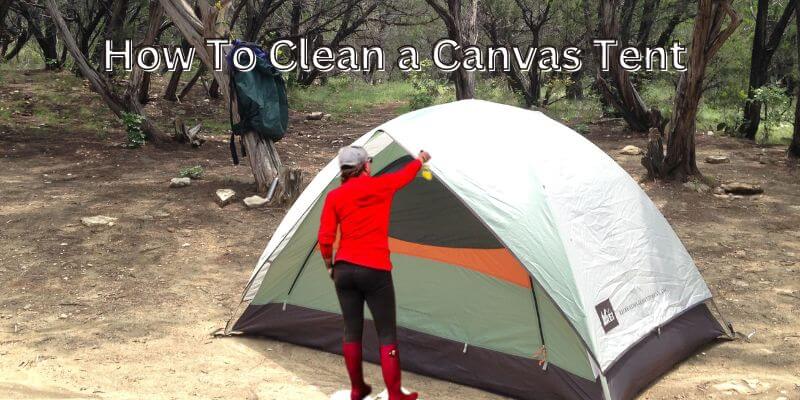Maintaining a canvas tent is akin to maintaining one’s health – it’s an investment that requires vigilance and a touch of foresight. Just as a balanced diet and regular exercise promote a long, vibrant life, proper tent care ensures your canvas shelter stands the test of time. Your canvas tent, like a trusted companion on your outdoor journeys, is an investment worth preserving. With a bit of proactive effort and a genuine concern for its longevity, you can enjoy the rewards of your canvas sanctuary for years to come.
If you’re reading this before the telltale signs of stains or the creeping menace of fungus appear on your canvas tent, you’re in luck. Below, we’ll provide invaluable tips and insights on cleaning and maintaining your canvas tent, ensuring it remains a steadfast partner on your adventures for generations. Think of this guide as your canvas tent’s health plan, designed to keep it vibrant, sturdy, and always ready to serve as your haven in the great outdoors.
“Well, canvas tents are pretty robust, but you do need to be gentle with them,” says a seasoned camper who’s been maintaining canvas tents for years. It all comes down to striking the proper balance between washing and protecting the cloth. There are certain tried-and-true procedures for cleaning them effectively and safely.” It all depends on the camping season.

Site Selection and Preparation
As soon as you reach your campsite or couple campsite after a long drive, there is excitement in the air. However, before rushing to pitch your tent, taking a little time to select the ideal spot can make a big difference. You should consider practicality amidst the beauty of nature.
What you should do: Find a flat, well-drained area away from low-lying areas where water can collect during rain. Remove any pebbles, wood, or debris that could damage the tent floor or cause pain while sleeping. Putting a little more thought into site selection can lead to a more comfortable and safe camping experience.
Why it matters: Choosing the right camping ground not only improves your comfort but also contributes to the longevity of your tent. Avoiding areas with flooding or sharp objects reduces the chance of damage and ensures that your tent remains a reliable shelter.
Read More: Best Tents For High Winds
Tent Setup
As soon as you start setting up the tent, the excitement between you and your camping partners is palpable. There is a strong desire to skip this important step and go straight to enjoying the beautiful outdoors. There are many traveling tools and equipment which are also important for camping.
What you should do: However, it is important to take your time when setting up a tent. To avoid bending or breaking tent poles and damaging the fabric, follow the manufacturer’s instructions carefully. Careful setup not only maintains the structural integrity of the tent but also reduces wear and tear over time.
Why it matters: Rushing the setup process can lead to costly mistakes. Careful operation and setup are essential to ensure that your tent remains strong and effective during your camping vacation.

Dealing with Stains and Mildew
A sudden storm can leave water stains and mold on your tent. Yes, it happens suddenly you even don’t get the idea of these stains and mildew. So in case of this just make sure to focus on checking every time. There are many tips on couple camping that will help you go with your partner with all your knowledge.
What you should do: In such cases, mix a mild detergent with water and gently clean the stains with a sponge or soft brush. Wash affected areas thoroughly and allow the tent to air dry completely before setting it up. This preventative method prevents mold growth and the formation of permanent water stains.
Why it matters: It’s important to treat stains and mildew as soon as possible to prevent long-term fabric damage and keep your tent waterproof. You can also use insulation on your tent to protect it.
Regular Cleaning During Your Trip
After a few days of camping, you find dirt, leaves, and even a little mud have made their way inside your tent.
What to do: It is critical to sweep out dirt and trash daily. Shake the rainfly and tent body to get rid of any dust. Wipe off the tent’s interior with a moist cloth if necessary. This prevents dirt from being embedded in the cloth.
Why it matters: Regular cleaning not only makes your living area comfortable, but it also decreases the chance of abrasion to the tent’s fabric, increasing its usable life.
Ground Tarp or Footprint
You’re wondering whether to use a ground tarp or footprint. It seems like an extra step, but you question whether it’s worthwhile.
What you should do: A ground sheet or footprint placed under your tent provides an extra layer of protection from sharp objects and wetness. While it may seem like it’s optional, the extra work is worth it in terms of extending the life of your tent and preserving its floor.
Why it matters: Ground tarps act as a barrier between your tent’s floor and the ground, preventing punctures and moisture ingress. This seemingly insignificant purchase can make a big difference in the long-term sustainability of your tent.
Post-Trip Cleaning
Our camping trip was excellent, but you came home tired and ready to sleep. After taking a good nap make sure to clean a canvas tent as soon as possible because it will help your canvas tent to go many years with you on camping.
What you should do: Resist the impulse to procrastinate as much as possible. When you get home, air out your tent again to remove any remaining dirt and moisture. Take this opportunity to thoroughly inspect the tent for damage and repair it as quickly as possible to prevent further deterioration.
Why it matters: Cleaning and airing your tent after each trip is essential to preventing the growth of mold and mildew, which can be especially troublesome if left unchecked.
Maintenance and Repairs
You notice a small tear in the tent fabric. The basic goals of maintenance and repairs are to avoid or address problems that may emerge as a result of normal wear and use, damage, or malfunction.
What you should do: Regularly inspect your tent for signs of wear and tear. If you find any damage, repair it as soon as possible using the manufacturer’s patch kit or comparable replacement. This preventive strategy prevents small difficulties from becoming big problems, saving you time and money.
Why it matters: Minor repairs should be dealt with as soon as possible to avoid worsening the condition and potentially requiring costly replacements. Regular maintenance is a simple yet efficient technique for maintaining the long-term usefulness of your tent.
Tent Cleaning Process
- Gather Your Materials
- Use a gentle detergent or a specialized tent cleaner.
- a sponge or a soft-bristled brush
- Bathtub or large tub
- Hose or light spray nozzle
- Towels or rags that are clean
- If necessary, use mildew remover.
- If necessary, use a seam sealer.
- Zipper cleaning
- Clean the zippers gently with a soft brush to eliminate any debris or grime. For smooth functioning, lubricate the zippers with a silicone-based zipper lubricant.
- Clear the Debris
- Shake off any loose dirt, leaves, or debris from the tent’s outside and rainfly.
- Construct the Cleaning Solution
- Fill a large tub or bathtub halfway with warm water.
- In the water, add a small amount of mild detergent or specialized tent cleaner. Harsh soaps and detergents should be avoided as they can harm the tent’s fabric and waterproof coatings.
- Clean Stains on the Spot
- Spot clean any stains on the tent fabric with a sponge or soft-bristled brush dipped in the cleaning solution.
- Tent Cleaning
- Set up the tent and rainfly (if necessary).
- Using the sponge or brush, gently scrub the tent’s exterior and rainfly with the cleaning solution.
- Pay close attention to any spots that have lingering stains, insect residue, or bird droppings.
Tips to Maintain and Clean Canvas Tent
Maintenance and cleaning are important to maintain the longevity of a canvas tent and keep it in good condition. Canvas tents are popular for camping, glamping, and outdoor events due to their durability and traditional look. Here are some guidelines for maintaining and cleaning a canvas tent:

- Keep it dry: Before storing your canvas tent, make sure it is completely dry to prevent mold and mildew from growing on it. If you have to pack up your tent while it’s wet, set it up to dry as soon as possible.
- Store it properly: Store your canvas tent in a cool, dry place out of direct sunlight to prevent it from fading or getting damaged by heat. It’s also important to store it in a place where rodents and insects can’t get to it.
- Sweep it clean: Before packing up your tent, use a broom or soft-bristled brush to sweep away any dirt, debris, or leaves that may be on the tent. This will make cleaning easier and prevent any abrasions or scratches.
- Spot clean: If you notice any stains or spots on your canvas tent. Spot-clean them with a mixture of water and mild soap. Use a soft-bristled brush or sponge to gently scrub the affected area. Then rinse it off with water and let it dry.
- Deep clean: To deep clean your canvas tent, set it up and use a hose to wet it down. Then, use a soft-bristled brush or sponge and mild soap to clean the entire tent. Rinse it off with the hose and let it dry completely before packing it up.
- Avoid harsh chemicals: Avoid using harsh chemicals. Such as bleach or fabric softeners, as they can damage the fabric of your canvas tent.
- Patch any holes: If you notice any holes or tears in your canvas tent, patch them up as soon as possible to prevent them from getting bigger. Use a canvas patch kit and follow the instructions carefully.
- Be gentle: Finally, when cleaning or maintaining your canvas tent, be gentle with the fabric and avoid using excessive force.
How to Spot Clean a Tent
Spot cleaning a canvas tent is a quick and easy way to remove small stains or marks without having to deep clean the entire tent. Here are the steps to spot-clean a canvas tent:

- Mix a solution: In a bucket, mix a solution of water and mild soap. Use a gentle soap that doesn’t contain any harsh chemicals or bleach.
- Apply the solution: Dip a soft-bristled brush or sponge into the solution and gently apply it to the affected area. Be careful not to use too much pressure or scrub too hard, as this can damage the fabric.
- Scrub gently: Use the brush or sponge to gently scrub the stain in a circular motion. Be sure to focus on the area where the stain is and avoid spreading it around.
- Rinse the area: Once the stain has been removed, rinse the area thoroughly with clean water. Use a hose or a clean bucket of water to rinse away any soap residue.
- Let it dry: Allow the area to air dry completely before packing up your tent. If possible, let the tent dry in the sun to speed up the process.
Removing Mold from a Tent
Mold on a canvas tent is not only unsightly, but it can also be a health hazard. Here are the steps to safely and effectively remove mold from a canvas tent:
- Set up the tent: Set up the canvas tent in a well-ventilated area where it can dry out completely. It’s important to wear gloves, a mask, and eye protection to protect yourself from mold spores.
- Brush off loose mold: Using a soft-bristled brush or a vacuum cleaner with a soft brush attachment, carefully brush off any loose mold from the tent. Be sure to dispose of the moldy debris safely.
- Mix a cleaning solution: In a bucket, mix a solution of warm water and white vinegar in equal parts. Alternatively, you can use a commercial mold and mildew cleaner that is safe for use on canvas.
- Apply the solution: Dip a soft-bristled brush or sponge into the cleaning solution and apply it to the affected areas. Be sure to cover the mold completely and work the solution into the fabric.
- Let it sit: Allow the cleaning solution to sit on the mold for at least 15 minutes to penetrate and kill the mold spores.
- Scrub the area: After the cleaning solution has sat for 15 minutes, use a soft-bristled brush or sponge to scrub the affected area. Be gentle but thorough, working the solution into the fabric.
- Rinse the tent: Rinse the tent thoroughly with clean water to remove all traces of the cleaning solution and mold.
- Dry the tent: Allow the tent to dry completely in the sun or a well-ventilated area. Be sure to avoid packing up the tent until it is completely dry to prevent the growth of mold or mildew.
Conclusion
Caring for your canvas tent is much the same as sustaining a priceless heritage. With appropriate care, your canvas tent will last for years, offering you and future generations with a dependable and rustic getaway into the great outdoors. This canvas shelter, like a treasured family heirloom, preserves the stories of numerous travels, whispering tales of starry nights and crisp morning breezes.
So, whether you’ve recently purchased a canvas tent or are rekindling your love for an old favorite, keep these suggestions and approaches in mind. You can guarantee that your canvas tent stays a treasured partner in your outdoor travels with dedication and a touch of reverence, an enduring monument to the experiences it has sheltered and those still to come.
FAQs
Here Are Some FAQs Related to Cleaning a Canvas Tent:
Q: Can I Wash My Canvas Tent in A Washing Machine?
A: It’s generally not recommended to wash a canvas tent in a washing machine, as the agitation and spinning can damage the fabric. Instead, it’s best to hand wash the tent or use a hose and soft brush to clean it.
Q: What Should I Use to Clean My Canvas Tent?
A: Use a mild soap, such as a liquid Castile soap or a soap specifically designed for canvas tents. Avoid using harsh chemicals, bleach, or anything that could damage the fabric.
Q: Can I Use a Pressure Washer to Clean My Tent?
A: It’s not recommended to use a pressure washer to clean a canvas tent, as the high pressure can damage the fabric and seams. Instead, use a hose and soft brush to clean the tent.
Q: How Do I Remove Mildew from My Canvas Tent?
A: To remove mildew from a canvas tent, mix a solution of warm water and white vinegar in equal parts, apply it to the affected area, and let it sit for at least 15 minutes. Then, scrub the area with a soft brush and rinse the tent thoroughly with clean water. Allow the tent to dry completely before packing it away.
Q: How Often Should I Clean My Tent?
A: The frequency of cleaning depends on how often you use the tent and how dirty it gets. It’s generally recommended to clean the tent after each use and to do a deep clean at least once a year.
Q: Can I Use a Fabric Softener on My Tent?
A: It’s not recommended to use a fabric softener on a canvas tent, as it can damage the fabric and reduce its water resistance. Instead, allow the tent to air dry completely and use a soft brush to remove any stiffness in the fabric.
You May Also Like:

